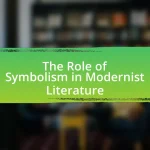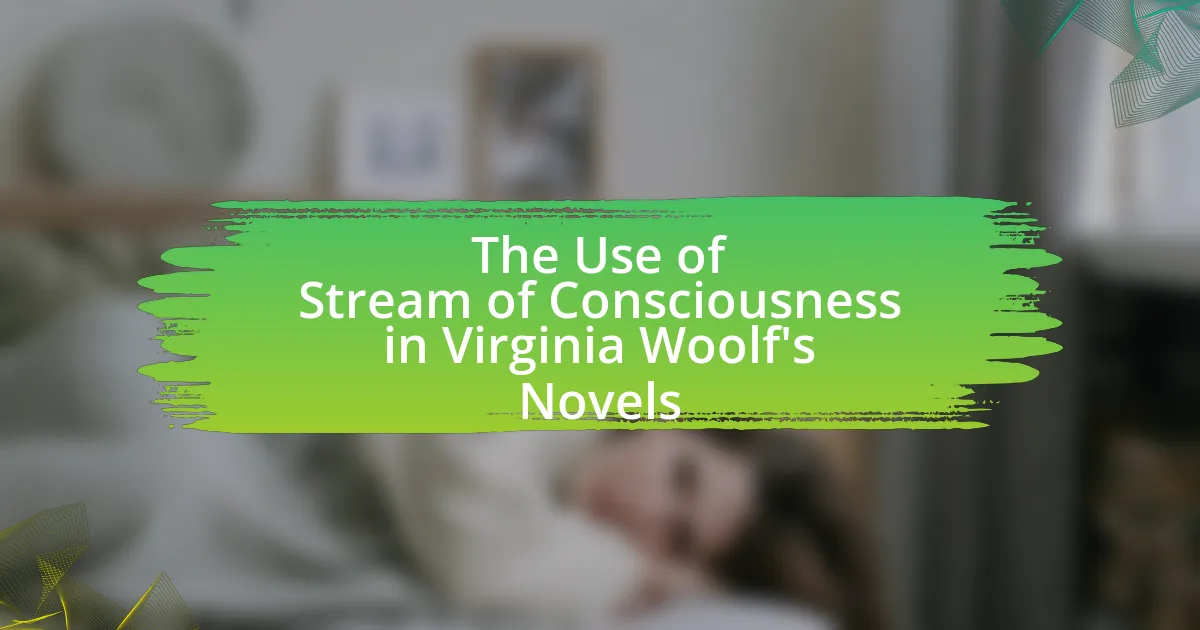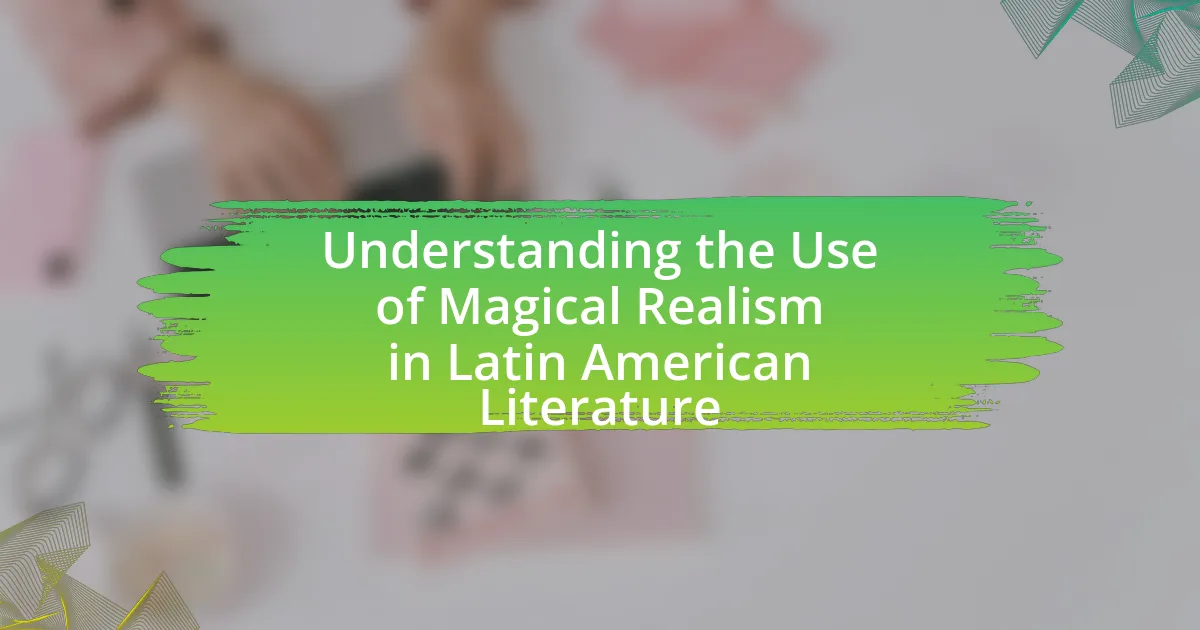The article examines the critical role of language and dialect in Southern Gothic fiction, highlighting how these elements establish regional authenticity and enhance character development. It discusses how authors like William Faulkner and Flannery O’Connor utilize colloquial speech and distinctive dialects to reflect the cultural complexities of the American South, shaping characters’ identities and social statuses. The article also explores the significance of specific dialects, the impact of language on thematic development, and the emotional resonance of narratives, ultimately illustrating how dialect contributes to the overall atmosphere and reader experience in Southern Gothic literature.
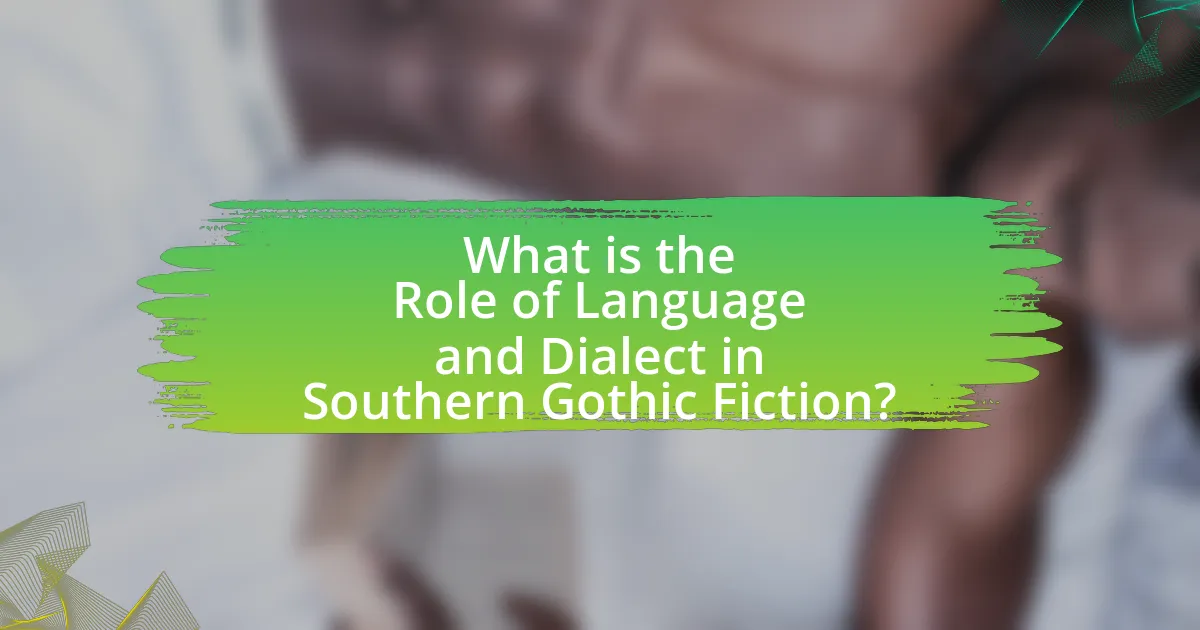
What is the Role of Language and Dialect in Southern Gothic Fiction?
Language and dialect play a crucial role in Southern Gothic fiction by establishing regional authenticity and enhancing character development. The use of colloquial speech and distinctive dialects reflects the cultural and social complexities of the American South, allowing readers to immerse themselves in the setting. For instance, authors like William Faulkner and Flannery O’Connor employ vernacular language to convey the unique identities and struggles of their characters, illustrating themes of isolation, decay, and moral ambiguity. This linguistic choice not only grounds the narrative in a specific locale but also deepens the emotional resonance of the stories, making the characters’ experiences more relatable and vivid.
How does language shape the identity of characters in Southern Gothic fiction?
Language shapes the identity of characters in Southern Gothic fiction by reflecting their social status, regional background, and psychological complexity. The use of dialect and colloquial expressions in works by authors like William Faulkner and Flannery O’Connor reveals the characters’ cultural heritage and personal struggles. For instance, Faulkner’s characters often employ a distinctive Southern vernacular that conveys their emotional states and societal roles, illustrating how language serves as a vehicle for identity formation. Additionally, the contrast between formal and informal speech can highlight tensions between characters, emphasizing themes of isolation and alienation prevalent in Southern Gothic narratives. This linguistic diversity not only enriches character development but also deepens the reader’s understanding of the socio-cultural landscape of the American South.
What specific dialects are commonly represented in Southern Gothic literature?
Southern Gothic literature commonly represents dialects such as Southern American English, African American Vernacular English (AAVE), and Cajun French. These dialects reflect the cultural and social complexities of the American South, contributing to the authenticity and depth of the characters and settings. For instance, Southern American English is characterized by unique phonetic features and vocabulary that evoke regional identity, while AAVE captures the historical and cultural experiences of African Americans in the South. Cajun French, prevalent in Louisiana, adds another layer of cultural specificity, showcasing the influence of French settlers and Creole culture. These dialects are integral to the narrative style and thematic exploration in Southern Gothic works, enhancing the portrayal of the South’s distinct social fabric.
How do characters’ speech patterns reflect their social status and background?
Characters’ speech patterns in Southern Gothic fiction reflect their social status and background through distinct dialects, vocabulary choices, and speech styles. For instance, characters from lower socioeconomic backgrounds often use colloquial language and regional dialects, which signify their cultural roots and limited access to formal education. In contrast, characters of higher social status typically employ more refined language, showcasing their education and social standing. This linguistic differentiation is evident in works like William Faulkner’s “The Sound and the Fury,” where the speech of the Compson family reveals their decline from aristocracy, while the speech of the African American characters highlights their resilience and cultural identity. Such speech patterns serve as a narrative device, illustrating the complexities of social hierarchies and personal histories within the Southern Gothic context.
Why is dialect important in conveying themes in Southern Gothic fiction?
Dialect is important in conveying themes in Southern Gothic fiction because it authentically reflects the cultural and social realities of the Southern United States. The use of regional dialects allows authors to create a vivid sense of place and character, which enhances the exploration of themes such as isolation, decay, and the complexities of Southern identity. For instance, in works by authors like William Faulkner and Flannery O’Connor, the distinct speech patterns and vocabulary of characters reveal their backgrounds and societal struggles, thereby deepening the reader’s understanding of the themes. This linguistic authenticity not only grounds the narrative in a specific cultural context but also serves to highlight the tensions and contradictions inherent in Southern life, making dialect a crucial tool for thematic development in Southern Gothic literature.
How does dialect contribute to the atmosphere of Southern Gothic narratives?
Dialect significantly contributes to the atmosphere of Southern Gothic narratives by enhancing authenticity and establishing a strong sense of place. The use of regional dialects reflects the cultural and historical context of the Southern United States, allowing readers to immerse themselves in the unique social dynamics and tensions present in these stories. For instance, the distinct speech patterns and vocabulary found in works by authors like William Faulkner and Flannery O’Connor create an intimate connection between characters and their environment, reinforcing themes of decay, isolation, and the grotesque. This linguistic authenticity not only deepens character development but also evokes the haunting, eerie qualities characteristic of Southern Gothic literature, making the setting itself a vital component of the narrative’s emotional impact.
What role does language play in the development of Southern Gothic motifs?
Language serves as a crucial vehicle for expressing Southern Gothic motifs by encapsulating the region’s unique cultural, social, and historical contexts. The use of dialect and colloquial speech in Southern Gothic literature not only reflects the authenticity of characters but also evokes the eerie and decayed atmosphere characteristic of the genre. For instance, authors like William Faulkner and Flannery O’Connor employ regional vernacular to enhance themes of isolation, moral decay, and the grotesque, thereby deepening the reader’s engagement with the narrative. This linguistic choice reinforces the Southern Gothic’s exploration of complex social issues, such as race and class, making the motifs more resonant and impactful.
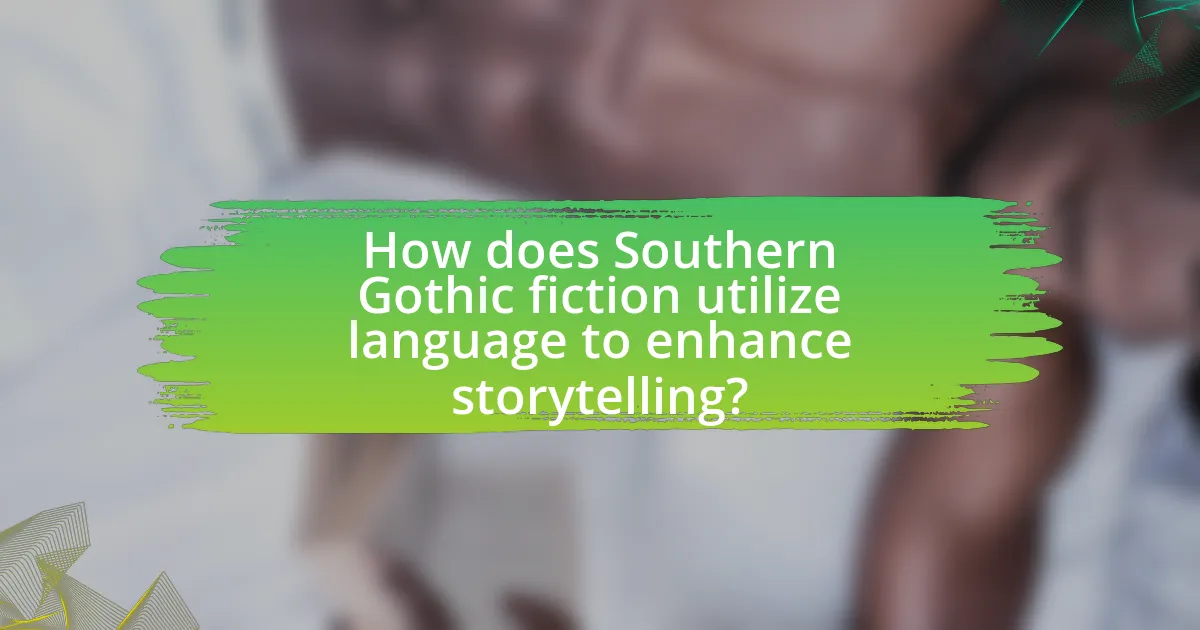
How does Southern Gothic fiction utilize language to enhance storytelling?
Southern Gothic fiction utilizes language to enhance storytelling by employing rich, evocative imagery and regional dialects that reflect the cultural and social complexities of the American South. This use of language creates a vivid sense of place and atmosphere, allowing readers to immerse themselves in the unique settings and characters. For example, authors like William Faulkner and Flannery O’Connor incorporate colloquial speech patterns and idiomatic expressions, which not only convey authenticity but also reveal character motivations and societal tensions. The intricate use of symbolism and metaphor further deepens the narrative, as seen in the works of Carson McCullers, where language serves to explore themes of isolation and moral decay. Thus, the strategic use of language in Southern Gothic fiction is essential for building emotional resonance and enhancing the overall impact of the storytelling.
What techniques do authors use to incorporate dialect into their narratives?
Authors incorporate dialect into their narratives through techniques such as phonetic spelling, idiomatic expressions, and character-specific speech patterns. Phonetic spelling captures the unique sounds and rhythms of a dialect, allowing readers to hear the voice of the character as intended. For example, Mark Twain’s use of phonetic spelling in “The Adventures of Huckleberry Finn” effectively conveys the Southern dialect, enhancing authenticity. Idiomatic expressions reflect cultural nuances and regional identity, enriching the narrative’s context. Additionally, character-specific speech patterns differentiate individuals and reveal their backgrounds, as seen in the works of authors like Zora Neale Hurston, who used dialect to portray the distinct voices of her characters in “Their Eyes Were Watching God.” These techniques collectively create a vivid and immersive reading experience that reflects the complexities of Southern Gothic fiction.
How does the use of vernacular influence reader perception of characters?
The use of vernacular significantly influences reader perception of characters by providing authenticity and cultural context. When characters speak in vernacular, it reflects their social background, regional identity, and personal experiences, allowing readers to form a deeper connection with them. For instance, in Southern Gothic fiction, authors like William Faulkner and Flannery O’Connor employ regional dialects to convey the complexities of their characters’ lives and societal norms. This linguistic choice not only enhances the realism of the narrative but also shapes readers’ interpretations of characters’ motivations and moral dilemmas, as seen in Faulkner’s “As I Lay Dying,” where the distinct voices of the Bundren family reveal their struggles and relationships.
What are the effects of code-switching in Southern Gothic literature?
Code-switching in Southern Gothic literature serves to highlight social and cultural tensions, revealing characters’ complexities and the societal divides within the Southern United States. This linguistic practice allows characters to navigate different social contexts, often reflecting their internal conflicts and the broader themes of identity and alienation prevalent in the genre. For instance, in works by authors like William Faulkner and Zora Neale Hurston, code-switching illustrates the characters’ struggles between their cultural heritage and the dominant societal norms, thereby enriching the narrative and deepening the reader’s understanding of the characters’ motivations and the historical context.
How does language reflect the cultural and historical context of the South?
Language in the South reflects its cultural and historical context through distinct dialects, idiomatic expressions, and vocabulary shaped by the region’s complex history, including colonization, slavery, and migration. For instance, the use of African American Vernacular English (AAVE) illustrates the influence of African heritage and the legacy of slavery, while Southern drawl and unique phrases reveal the region’s rural roots and social hierarchies. Historical events, such as the Civil War and the Civil Rights Movement, have also left their mark on language, as seen in the evolving terminology surrounding race and identity. These linguistic features not only convey local identity but also serve as a means of resistance and cultural preservation, highlighting the South’s rich tapestry of experiences and traditions.
What historical events influence the dialects found in Southern Gothic fiction?
The dialects found in Southern Gothic fiction are influenced by historical events such as the Civil War, Reconstruction, and the Great Migration. The Civil War (1861-1865) led to significant social and economic changes in the South, resulting in a blend of dialects as communities were disrupted and reshaped. Reconstruction (1865-1877) further transformed Southern society, introducing new cultural dynamics and linguistic influences as formerly enslaved individuals began to assert their identities. Additionally, the Great Migration (1916-1970), where African Americans moved from the rural South to urban areas in the North, contributed to the evolution of Southern dialects as these communities interacted with different linguistic environments. These events collectively shaped the rich tapestry of language and dialect in Southern Gothic literature, reflecting the complexities of Southern identity and history.
How do regional expressions contribute to the authenticity of the setting?
Regional expressions enhance the authenticity of the setting by reflecting the unique cultural and historical context of a specific area. In Southern Gothic fiction, these expressions serve as linguistic markers that ground characters in their geographical and social environments, making their experiences more relatable and believable. For instance, the use of colloquial language and idiomatic phrases specific to the Southern United States evokes a sense of place and identity, reinforcing the narrative’s connection to its regional roots. This linguistic authenticity not only enriches character development but also immerses readers in the distinct atmosphere of the Southern Gothic genre, characterized by its exploration of decay, isolation, and the complexities of Southern life.
What are the implications of language and dialect on the reader’s experience?
Language and dialect significantly shape the reader’s experience by influencing comprehension, emotional engagement, and cultural context. The use of regional dialects in Southern Gothic fiction, for example, immerses readers in the setting and enhances authenticity, allowing them to connect more deeply with characters and themes. Studies show that dialect can evoke specific emotional responses; for instance, the distinct vernacular of Southern characters can create a sense of familiarity or alienation, depending on the reader’s background. This linguistic choice not only enriches the narrative but also reflects social hierarchies and cultural nuances, thereby deepening the reader’s understanding of the story’s context and the characters’ motivations.
How does language affect the emotional impact of Southern Gothic stories?
Language significantly affects the emotional impact of Southern Gothic stories by creating a distinct atmosphere and deepening character development. The use of regional dialects and vivid imagery evokes a sense of place and cultural identity, which enhances the reader’s emotional connection to the narrative. For instance, the rich, descriptive language often employed by authors like William Faulkner and Flannery O’Connor captures the complexities of Southern life, including themes of decay, isolation, and moral ambiguity. This linguistic style not only reflects the characters’ inner turmoil but also immerses readers in the haunting landscapes and societal issues prevalent in the South, thereby intensifying the overall emotional experience.
What are the challenges readers face when encountering dialect in these texts?
Readers face significant challenges when encountering dialect in Southern Gothic fiction, primarily due to the complexity of understanding regional vernacular and cultural references. The use of dialect can create barriers to comprehension, as it often includes idiomatic expressions, phonetic spellings, and unique grammatical structures that differ from standard English. This linguistic variation may lead to misinterpretation of characters’ intentions and emotions, as well as hinder the overall narrative flow. Additionally, readers unfamiliar with the cultural context may struggle to grasp the subtleties and nuances embedded in the dialect, which are crucial for fully appreciating the themes and character development in the texts.
How can understanding dialect enhance the appreciation of Southern Gothic fiction?
Understanding dialect enhances the appreciation of Southern Gothic fiction by providing insight into the cultural and social contexts of the characters and settings. The use of regional dialects reflects the unique histories, traditions, and struggles of Southern communities, allowing readers to connect more deeply with the narrative. For example, authors like William Faulkner and Flannery O’Connor employ dialect to convey authenticity and to illustrate the complexities of Southern identity, which enriches the reader’s experience and understanding of the themes presented in their works. This linguistic authenticity not only grounds the stories in a specific locale but also evokes the emotional and psychological landscapes of the characters, making the fiction more relatable and impactful.
What best practices can readers adopt to engage with Southern Gothic dialects?
Readers can engage with Southern Gothic dialects by actively listening to authentic recordings of the dialect and practicing reading aloud to capture its unique rhythm and intonation. This approach allows readers to familiarize themselves with the phonetic nuances and cultural context inherent in the dialect. Research indicates that exposure to spoken language significantly enhances comprehension and retention of dialect features, as noted in studies on language acquisition. Additionally, readers should explore literature that exemplifies Southern Gothic dialects, such as works by authors like William Faulkner and Flannery O’Connor, to understand the dialect’s role in character development and thematic expression. Engaging with these texts provides insight into the social and historical factors that shape the dialect, further enriching the reader’s experience.
How can readers familiarize themselves with Southern dialects before reading?
Readers can familiarize themselves with Southern dialects before reading by engaging with audio resources, such as podcasts and audiobooks featuring Southern speakers. These resources provide authentic examples of pronunciation, intonation, and colloquial expressions unique to various Southern regions. Additionally, studying written works by Southern authors, such as Mark Twain or Zora Neale Hurston, allows readers to observe dialect in context, enhancing their understanding of linguistic nuances. Research indicates that exposure to diverse dialects improves comprehension and appreciation of regional literature, making these methods effective for readers preparing to explore Southern Gothic fiction.
What resources are available for understanding the language of Southern Gothic fiction?
Resources available for understanding the language of Southern Gothic fiction include academic texts, literary analyses, and online databases. Notable academic texts such as “Southern Gothic: A Literary History” by Charles L. Crow and “The Southern Gothic: A Reader” edited by Michael Kreyling provide in-depth explorations of the genre’s language and themes. Literary analyses, including articles from journals like “American Literature” and “The Southern Review,” often dissect specific works and their linguistic features. Online databases such as JSTOR and Project MUSE offer access to scholarly articles and papers that focus on the dialects and stylistic elements characteristic of Southern Gothic fiction. These resources collectively enhance the understanding of the unique language and dialect used in this literary tradition.

